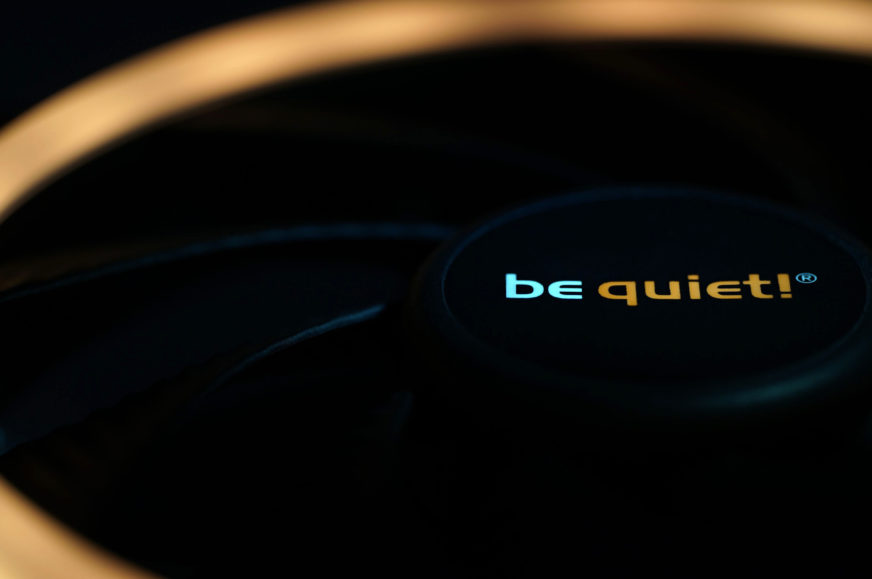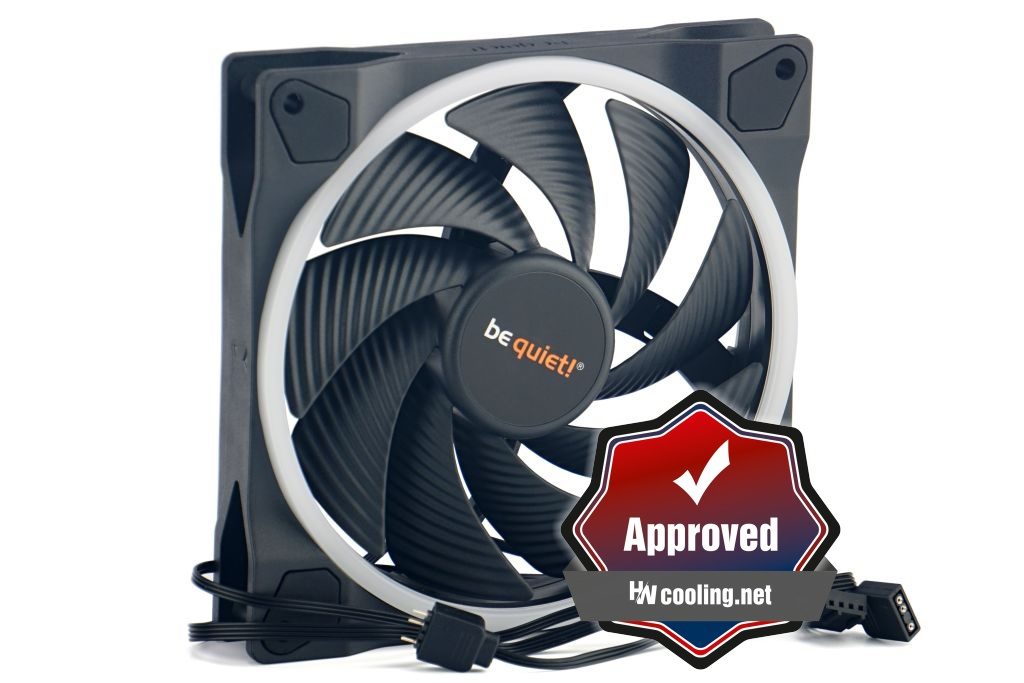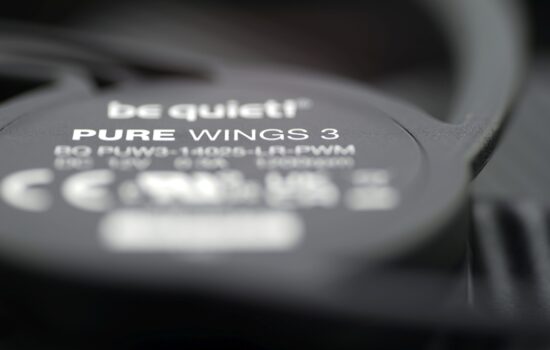Evaluation
We analyzed the “Light Wings” fan fairly recently, but that was in the 120 mm format. BeQuiet! approached the 140mm model a little differently. Although the frame is only proportionally enlarged, the shape of the rotor is already significantly different. It relies on long, curved blades, which look great in this cross-section, but there are some design caveats. Still, in some applications, this fan excels.
Evaluation
During testing, we couldn’t help wondering “what kind of results would this fan achieve with a rotor made of LCP”. The more flexible material is what makes the Light Wings 140 mm fan design noisier at some sound frequencies, and why even in modes normalized by fixed noise levels it often doesn’t come out as well as it might if it were constructed from a more rigid material. The one used is more flexible, but for the proportions of this format it is still relatively stiff due to its greater thickness.
One of the fundamental advantages of Light Wings (BL075) fans is the extremely wide speed range with very low minimum speeds. Some may consider the lower LED luminosity to be a disadvantage, fans with circular lighting in the frame can’t compete with models that have the whole rotor lit.
Najviac The 140-millimeter Light Wings fan fits use with a plastic dust filter or on a grille at lower speeds below 1,000 rpm. This is outside the critical band, so the fan sound does not disturb too much. And also due to the above-standard airflow in these conditions (with a filter and a grille) we can say that this is an attractive system fan. The operation of the motor and bearings is virtually noiseless, so even demanding users with sensitive hearing will not complain.
It’s worse at higher speeds, above 1150 rpm, where the fan sound is rumblier, dominated by lower frequencies. While on a grille they keep relatively in the background (and the most pronounced is the common “hum” at 370–450 Hz), on a radiator we recorded quite strong 139 Hz for example even at lower speeds. Even so, it’s worth noting that the 140mm Light Wings is on par with the most efficient 120mm fans. But for this larger format (140 mm) it is naturally a sign of mediocrity.
On radiators, the lighted BeQuiet! fan has a rather more attractive cooling performance-to-noise ratio compared to the Fractal Design Aspect 14 RGB PWM, regardless of profile structure. So the big leap forward of the Light Wings fan is there as much on a thinner radiator with denser finning as it is even on a thicker, but less dense, radiator with lower FPI. But it comes at the price of a more unpleasant sound, which is something we’ll encounter quite often with long-bladed 140mm fans.
The strongest vibrations are around 1250 rpm. At this or similar speeds, the build can get really noisy, especially when it contains multiple 140mm Light Wings fans. While the vibrations are dampened (by rubber pads), they are still transmitted to the fan frame (and from there to the case or a radiator).
The Light Wings was the first to take the criticism for “noisy blades” from 140mm fans, but it certainly can’t be ruled out that it will end up being one of the most acceptable options within its category, which is determined by the format and the ARGB lighting. The blades of competing fans aren’t much stiffer, and if the fan is to hit maximum efficiency within its cross-section, then its shape has to be built around long curved blades. Models with blades with a profile similar to an equilateral triangle will indeed be more stable, but they won’t reach the top ranks in any situation. Time will tell which 140mm fans excel at what, but for now we are at the beginning, without a proper database of results to draw full conclusions.
English translation and edit by Jozef Dudáš
| BeQuiet! Light Wings (BL075) |
| + Suitable for any scenario |
| + Decent price/cooling performance ratio for a lighted fan |
| + Cooling efficiency (airflow/pressure per unit of noise) at a very high level |
| + Very high effectiveness even with dust filters |
| + Exceptionally wide speed range |
| + Very low speeds possible (stable from approx. 255 rpm) |
| + Virtually noiseless operation of bearings and motor |
| + ARGB LED lighting |
| - Higher vibration |
| - The sound is characterised by rumbling frequencies. For some, they may be unpleasant |
| - Inefficient ARGB LED illumination (above-average power draw, below-average luminosity) |
| - Collides with nylon dust filter |
| Approximate retail price: 29 EUR |
- Contents
- BeQuiet! Light Wings (BL075) in detail
- Basis of the methodology, the wind tunnel
- Mounting and vibration measurement
- Initial warm-up and speed recording
- Base 6 equal noise levels…
- ... and sound color (frequency characteristic)
- Static pressure measurement…
- … and airflow
- Everything changes with obstacles
- How we measure power draw and motor power
- Measuring the intensity (and power draw) of lighting
- Results: Speed
- Results: Airlow w/o obstacles
- Results: Airflow through a nylon filter
- Results: Airflow through a plastic filter
- Results: Airflow through a hexagonal grille
- Results: Airflow through a thinner radiator
- Results: Airflow through a thicker radiator
- Results: Static pressure w/o obstacles
- Results: Static pressure through a nylon filter
- Results: Static pressure through a plastic filter
- Results: Static pressure through a hexagonal grille
- Results: Static pressure through a thinner radiator
- Results: Static pressure through a thicker radiator
- Results: Static pressure, efficiency by orientation
- Reality vs. specifications
- Results: Frequency response of sound w/o obstacles
- Results: Frequency response of sound with a dust filter
- Results: Frequency response of sound with a hexagonal grille
- Results: Frequency response of sound with a radiator
- Results: Vibration, in total (3D vector length)
- Results: Vibration, X-axis
- Results: Vibration, Y-axis
- Results: Vibration, Z-axis
- Results: Power draw (and motor power)
- Results: Cooling performance per watt, airflow
- Results: Cooling performance per watt, static pressure
- Airflow per euro
- Static pressure per euro
- Results: Lighting – LED luminance and power draw
- Results: LED to motor power draw ratio
- Evaluation












